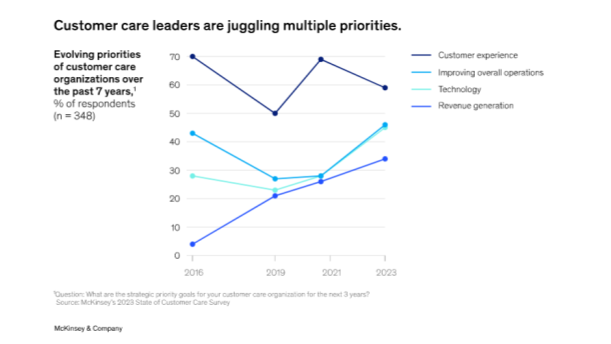The last few years have highlighted the need for accelerated digital transformation. Customer behavior has drastically changed as people now look for connection and meaningful support from brands and businesses. Customers now expect customer service representatives to have more emotional empathy in their interactions and focus on faster issue resolution. It is essential to recognize that while automation can enhance efficiency, the human element remains irreplaceable.
This article will discuss the shift toward human-centric digital transformation as more organizations prioritize customer experience. We will also discuss balancing digital and human interactions to provide exceptional customer experiences.
Exploring the Shift in Customer Values
Before the pandemic, customers valued convenience and speed. While these factors remain important, there has been a significant shift towards human connections. According to a study by PwC, up to 50% of consumers are loyal to businesses offering more significant human interaction in their customer service experiences.
Today’s customers seek brands that prioritize empathy and convenience during interactions. They want to feel heard and valued, and 50% are rethinking their priorities. 55% of customer service teams also reported customers are inclined to interact over digital channels.
Benefits & Challenges of Automation in Customer Experience
Automation is a strategic approach to improving efficiency while meeting evolving consumer demands. Automating routine tasks frees customer service representatives to focus on more complex or high-touch interactions.
The key advantages of automating the customer experience are:
- 24/7 Availability: Automated systems like chatbots and virtual assistants (VAs) provide round-the-clock support, ensuring customers get assistance whenever needed.
- Speed and Efficiency: Chatbots, VAs, and robo-advisors can swiftly handle routine queries and tasks. It improves the efficiency of human agents, allowing them to work on complex issues.
- Consistency: Automated responses ensure consistency in customer interactions, reducing the risk of human error.
- Cost-Effectiveness: Automating repetitive tasks reduces operational costs, allowing organizations to allocate resources more effectively.
- CX automation speeds up customer interaction, but there are also challenges that impact the quality of customer interactions. Some drawbacks of automation are:
- Lacks Personalization: Automated systems do not provide the personalized touch that customers need. They may not fully understand the context of a customer’s issue.
- Emotional Disconnect: Machines lack empathy and emotional intelligence. 72% of customers say interacting with automated customer service solutions wastes time, while another 80% of them find it frustrating.
- Limited Problem-solving Capabilities: Automated systems can handle simple queries, but 63% of complex issues remain unresolved. 78% of customers state they were connected with human representatives after automated service assistants failed to resolve their problems.
The Future of CX: A Balanced Approach
Balancing automation and human expertise delivers delightful customer experiences. Businesses that successfully blend the two can provide a seamless, efficient, and emotionally satisfying customer journey.

According to McKinsey, customer care leaders have prioritized customer experiences over the past seven years. However, their focus on revenue generation is also growing. The report emphasizes that leaders must find the right balance between automation and human touch.
Here are some ways to offer a great CX through automation with a human touch:
- Leverage AI for Personalization: 76% of customers expect personalizations in service delivery in exchange for sharing their data. AI-powered systems analyze customer data to understand their preferences, anticipate needs, and provide relevant solutions.
- Provide Empathy Training: Train employees on emotional empathy. Human agents must listen actively, show understanding, and take ownership of customer issues. Use Natural Language Processing (NLP) based automation to detect customer sentiment and provide more emotionally intelligent responses.
- Use Technology to Empower Humans: ML and NLP technologies can assist human agents in resolving customer issues more effectively. They provide customer service representatives with relevant contextual data from previous interactions and cues about customer moods. 60% of customer service agents agree that AI-based systems allow them to personalize customer resolutions.
- Offer Omnichannel Support: Customers prefer different communication channels depending on their needs and expectations. An omnichannel approach enables customers to switch channels without losing context. Businesses must provide a seamless and personalized experience across all channels.
Examples of Successful Blending of Automation and Human Touch
- Sephora, the leading beauty brand, uses AI-powered chatbots to handle routine inquiries. Their human beauty advisors are available on demand for personalized consultations.
- Zappos is known for its exceptional customer service. The company combines automated systems for efficiency with a dedicated team of human agents to delight customers.
- Turbotax uses AI to provide personalized tax recommendations and solutions to its customers. However, it also offers customers the option to speak with a human tax specialist if they need further assistance.
Empowering the Frontline
Customer support teams need to be empowered to deliver exceptional customer experiences. Businesses must provide the right tools and train them to juggle complex issues while maintaining a human touch.
Some ways to empower frontline employees are:
- Automating Routine Tasks: Support agents must focus on more meaningful interactions and complex problem-solving. Automation can handle mundane tasks like data entry, scheduling appointments, and sending reminders.
- Comprehensive Training: Organizations must train customer service representatives in the latest technology, empathy, and communication skills. They must also provide relevant information about the company’s products or services.
- Knowledge Bases: Comprehensive knowledge bases provide agents with quick access to information, enabling them to offer accurate and timely solutions.
- Real-Time Information: Equipping agents with real-time data and context using CRM systems, customer history, and sentiment analysis can help them provide more personalized solutions. It helps them make informed decisions during customer interactions.
Conclusion
Digital transformation and automation are driving modern customer experiences. However, customers value genuine connections, empathy, and personalized support. Organizations can provide emotionally satisfying customer journeys by balancing automation and human expertise.
Empowering frontline employees allows them to create memorable and meaningful customer experiences. By doing so, the customer experience remains at the heart of each customer’s journey. For businesses, it improves the bottom line and fosters long-term brand loyalty.
